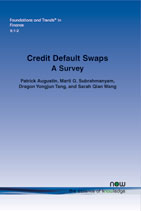Credit Default Swaps: A Survey
By Patrick Augustin, McGill University — Desautels Faculty of Management, Canada, Patrick.Augustin@mcgill.ca | Marti G. Subrahmanyam, New York University — Leonard N. Stern School of Business, USA, msubrahm@stern.nyu.edu | Dragon Yongjun Tang, University of Hong Kong — Faculty of Business and Economics, Hong Kong, yjtang@hku.hk | Sarah Qian Wang, University of Warwick — Warwick Business School, UK, Qian.Wang@wbs.ac.uk
Abstract
Credit default swaps (CDS) have been growing in importance in the global financial markets. However, their role has been hotly debated, in industry and academia, particularly since the credit crisis of 2007–2009. We review the extant literature on CDS that has accumulated over the past two decades. We divide our survey into seven topics after providing a broad overview in the introduction. The second section traces the historical development of CDS markets and provides an introduction to CDS contract definitions and conventions. The third section discusses the pricing of CDS, from the perspective of no-arbitrage principles, structural, and reduced-form credit risk models. It also summarizes the literature on the determinants of CDS spreads, with a focus on the role of fundamental credit risk factors, liquidity and counterparty risk. The fourth section discusses how the development of the CDS market has affected the characteristics of the bond and equity markets, with an emphasis on market efficiency, price discovery, information flow, and liquidity. Attention is also paid to the CDS-bond basis, the wedge between the pricing of the CDS and its reference bond, and the mispricing between the CDS and the equity market. The fifth section examines the effect of CDS trading on firms' credit and bankruptcy risk, and how it affects corporate financial policy, including bond issuance, capital structure, liquidity management, and corporate governance. The sixth section analyzes how CDS impact the economic incentives of financial intermediaries. The seventh section reviews the growing literature on sovereign CDS and highlights the major differences between the sovereign and corporate CDS markets. In the eight section, we discuss CDS indices, especially the role of synthetic CDS index products backed by residential mortgage-backed securities during the financial crisis. We close with our suggestions for promising future research directions on CDS contracts and markets.
Credit Default Swaps
Credit Default Swaps: A Survey is the most comprehensive review of all major research domains involving credit default swaps (CDS). CDS have been growing in importance in the global financial markets. However, their role has been hotly debated, in industry and academia, particularly since the credit crisis of 2007-2009. The authors review the extant literature on CDS that has accumulated over the past two decades and divide the survey into seven topics after providing a broad overview in the introduction. The second section traces the historical development of CDS markets and provides an introduction to CDS contract definitions and conventions. The third section discusses the pricing of CDS, from the perspective of no-arbitrage principles, structural, and reduced-form credit risk models. It also summarizes the literature on the determinants of CDS spreads, with a focus on the role of fundamental credit risk factors, liquidity and counterparty risk. The fourth section discusses how the development of the CDS market has affected the characteristics of the bond and equity markets, with an emphasis on market efficiency, price discovery, information flow, and liquidity. Attention is also paid to the CDS-bond basis, the wedge between the pricing of the CDS and its reference bond, and the mispricing between the CDS and the equity market. The fifth section examines the effect of CDS trading on firms' credit and bankruptcy risk, and how it affects corporate financial policy, including bond issuance, capital structure, liquidity management, and corporate governance. The sixth section analyzes how CDS impact the economic incentives of financial intermediaries. The seventh section reviews the growing literature on sovereign CDS and highlights the major differences between the sovereign and corporate CDS markets. The eighth section discusses CDS indices, especially the role of synthetic CDS index products backed by residential mortgage-backed securities during the financial crisis. The authors close with our suggestions for promising future research directions on CDS contracts and markets.
